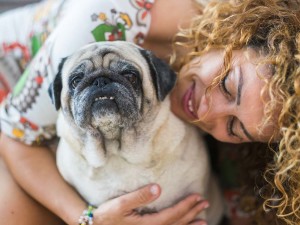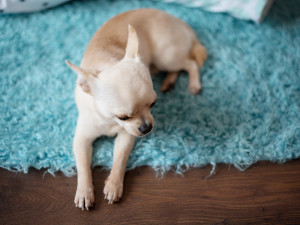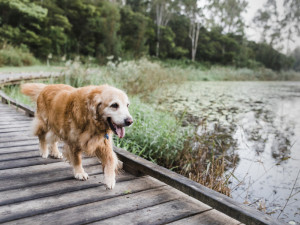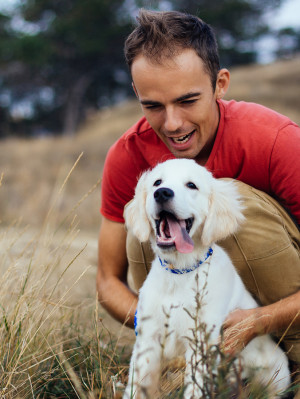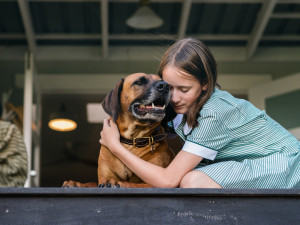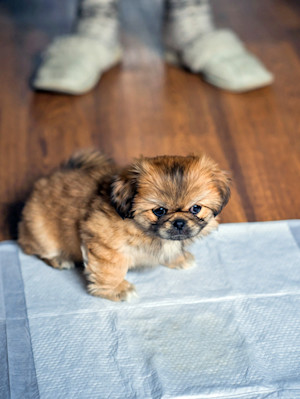How to Get Your Dog to Wear a Diaper
And why they might need one.
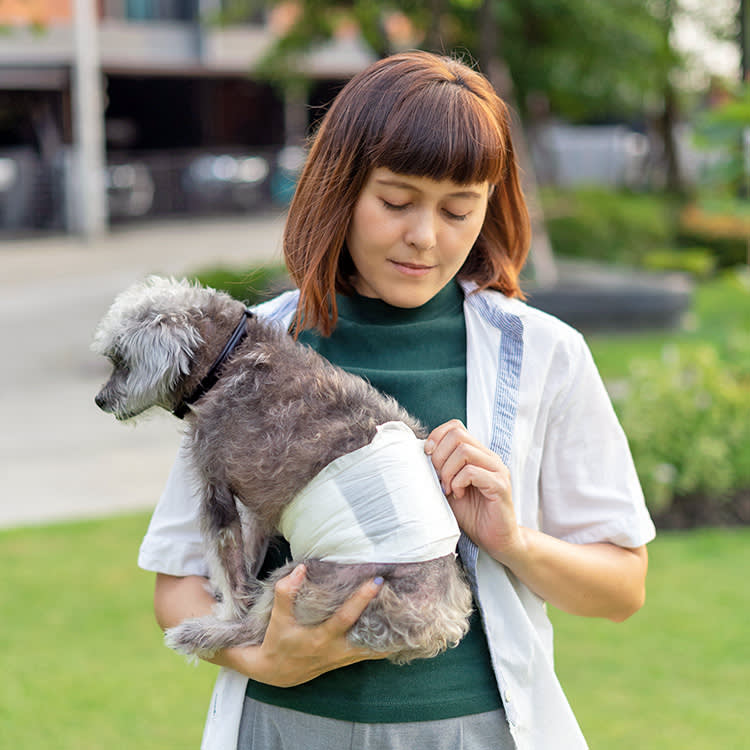
Share Article
In This Article:
Pros and Cons of Dog Diapersopens in a new tab Diaper Selection and Fittingopens in a new tab How to Introduce a Diaperopens in a new tab Care and Hygieneopens in a new tab Alternatives to Diapersopens in a new tab Frequently Asked Questionsopens in a new tab
In unique circumstances, dogs may need to wear a diaper, though often this is considered a last resort. There are many challenges in keeping dogs clean and healthy in diapers. It is always worth considering all the other options that may be effective solutions and speaking with a vet before turning to diapers.
If you have determined that diapers are the only option for your pup, you’ll want to take your time to find the best fit and get your pup adjusted to wearing them. Start by selecting the appropriate size and fit. Introduce the diaper with treats and praise, for short periods initially, offering rewards and distractions. Be consistent, calm, and never force the diaper.

littleKin™ is Kinship’s home just for puppy and kitten parents. Bop over to check out expert advice, new pet tools, and special deals—all curated for your newest family member.
opens in a new tabPros and cons of dog diapers
Diapers carry a lot of potential cons, so it is important to carefully identify situations where their use is necessary. The biggest pro of diaper use is that it contains the mess from pee, poop, or dogs in heatopens in a new tab. In healthy dogs who can be potty trained, diapers should never be used as an alternative; they cause potential health complications. That said, there are cases where diapering is necessary and can be managed when pet parents are able to provide the necessary round-the-clock care and monitoring.
Reasons your dog may need a diaper
Incontinence management: This is the primary reason dogs may need diapers long-term. Dogs with urinary or fecal incontinence have no control over their urine and poop and cannot be trained to hold it until their next walk. Without a diaper or other method to contain their urine and poop, they would otherwise have accidents in the house.
Neurological problemsopens in a new tab, spinal injuriesopens in a new tab, severe joint disease: Dogs with injuries or congenital abnormalities in their spine or nerves may be unable to stand or walk. These injuries can sometimes damage the nerves connected to the bladder and rectum. Affected dogs may be incontinent as a result. Other times, they may have some control over their urine and poop but are unable to posture properly to push it out. This can also happen in senior dogsopens in a new tab with advanced arthritis, other joint disease, or cognitive dysfunctionopens in a new tab. Depending on the specifics of their injury and challenges, there may be other alternatives to diapering.
Menstrual management: Intact female dogs will go into heat approximately every six months once they reach sexual maturity. During their heat cycle, they will have bloody vaginal discharge and pet parents may need to contain the blood to avoid destruction of their property. Diapers may be a short-term solution in this case. But other effective solutions exist, including spaying female dogsopens in a new tab to prevent future heat cycles and protect against reproductive health problems.
Post-surgical care: Diapering is not recommended in these cases due to the risks of skin infections and most often, alternatives are recommended to support their mobility during recovery.
Potty training: Traditional diapering is not recommended as an alternative to, or in conjunction with potty trainingopens in a new tab. This is because dogs need to learn to be aware of when they are peeing and pooping and to associate doing so outdoors with a positive reward. If they are wearing a diaper, they are not going to make that association.
Additional considerations
Small vs. large breed differences: Finding a properly fitting diaper presents different challenges depending whether you have a small breed or large breed dog. While it may be difficult to find a diaper that is snug enough for a very small dog, large and giant breed dogs may be too large for most standard diapers and it may take some creative engineering to find a viable option.
Coat considerations: Dogs with long coats are going to have more challenges both with getting a diaper to stay snugly in place over their poofy fur. They will also have trouble with pee or poop getting stuck in their fur. They may benefit from getting their fur trimmedopens in a new tab short around their hind end, belly, and butt to reduce these issues.
Individual temperament: Not every dog will be cool with wearing a diaper, so you’ll have to evaluate whether there is an effective alternative available, or whether you can very slowly desensitize them to the experience.
How to select and fit a dog diaper
As you consider the best option for your dog, it is also important to consider the added care your pup will need in diapers. Be sure you or another member of your family will be available to change the diaper frequently. Diapers need to be changed soon as pups pee or poop or at least six to eight times per day for dogs who continuously leak urine. You’ll also have to be prepared to do additional baths to protect your pup’s skin and hind end from infections and other complications. This may result in more frequent veterinary visits or expenses, so be sure to plan ahead for these complicationsopens in a new tab. If you are prepared for the journey of managing your pup in diapers, here are some additional considerations for finding the proper diaper:
Types of dog diapers
Depending on your dog’s condition and needs, different kinds of diapers may be more suitable:
Disposable diapers: Disposable diapers have the benefit of not needing to be cleaned and reused. This may be best for pet parents without easy access to a washer/dryer, as well as in situations where there is a large amount of urine or feces that may be difficult to fully clean out of a diaper. Of course, from a sustainability point of view, disposable diapers create more waste.
Reusable cloth diapers: Cloth diapers offer advantages in sustainability and may be more cost-efficient long term since they can be reused. Cloth fabric may also be less irritating on the skin for some dogs. Some cloth diapers may still require a disposable insert to absorb large amounts of urine and it may be difficult to get the odor of urine or feces out of some materials.
Medical/incontinence diapers: Dogs that are constantly dribbling urine or urinate large amounts of urine may need thicker, more absorbent diapers in order to wick away all of that moisture and keep their skin dry.
Breed-specific designs: Dogs come in all shapes and sizes so understandably, their anatomical differences will influence what kinds of diapers will fit them best. While there may not be specific diapers for every breed out there, you may be able to modify certain diapers to meet your pup’s needs.
Belly bands: Belly bands, as the name suggests, are diapers that wrap around a dog’s midsection at the level of their penis. These are intended only for male dogs and do not cover their butt or hind end at all. They can be a good alternative for male dogs that only have urinary issues and may be more comfortable than a diaper that covers their whole hind end.
DIY dog diapers: For a variety of reasons, you may need to get creative and tailor the existing options to suit your dog’s needs. You can start with a product that is available and try to make certain tweaks for your dog’s individual needs.
How to size and fit a dog diaper
Ensuring a proper fit is necessary both to prevent leakage and to minimize complications, like skin irritation and infections. Some points to keep in mind are:
Measuring your dog: Before purchasing any products, be sure to measure your dog to get an idea of their size and coverage needs. You may need to measure their circumference or the narrowest and widest parts of their belly and hips in addition to the length from their waist to their tail.
Gender-specific designs: You will likely encounter many products marketed specifically for male and female dogs so consider your dog’s gender and needs when evaluating these products.
Diapers for male dogs: Diapers for male dogs are often the belly-band style, which cover their penis but do not cover their hind end at all. If you have a male dog that has poop accidents, this design will not be effective, and you’ll have to opt for a design that will cover their hind end.
Diapers for female dogs: Diapers for female dogs are full-coverage hind end diapers that usually have a tail hole. They are not usually specific for females in any other way and can be used for male dogs that need the full hind end coverage as well.
Weight and body shape: When looking at the available products on the market, you’ll notice that most come in at least three sizes based on waist size, and that each one covers a range of measurements. Velcro and elastic closures allow the diapers to be adjusted for variations in size so in most cases, you’ll be able to adjust the diaper accordingly. It is best to purchase a few different styles and varieties to find the best fit for your pup.
Proper placement: As you test out different diaper styles, pay close attention to the placement and fit. Be sure the diaper is covering the necessary areas to catch all urine and poop without leakage and that the diaper is not too tight in any particular areas.
Ensuring mobility: Be sure that once the diaper is in place, your dog can comfortably move all their limbs and their tail. If the diaper is interfering with their movement or rubbing consistently in any particular place, this may set them up for complications and will need to be modified.
How to introduce a diaper
Just like anything new you want to introduce to your pup, it will require a gradual, patient approach for some dogs to accept wearing a diaper. Dogs who are paralyzed in their lower back or hind legs may not be able to feel the diaper at all, and that may make it a lot easier for them to accept it. In all cases, you’ll want to have an intentional approach to introducing the diaper.
How to get your dog to wear a diaper
Create a calm environment: When you initially test out the diaper, be sure to do so in a calm, quiet environment. A trip out of town or a day when your house is under construction would not be the time to try out a diaper. Set your pup up for success by selecting an ideal time and place.
Introduce a diaper: Allow your dog to sniff the diaper and check it out before putting it on them. Use a calm, reassuring voiceopens in a new tab to speak with your pup and lots of praise and treats to help them create a positive association with the diaper.
Redirect attention: Once the diaper is in place, you can use redirection techniques to prevent your dog from biting at the diaper and/or attempting to take it off. Whenever your dog starts paying too much attention to the diaper, redirect them to a more desirable activity like playing with a toy, performing a set of trained cuesopens in a new tab, or another fun activity.
Short initial wear times: You’ll want each experience with the diaper to end on a positive note, so keep the first few attempts short and sweet. Remove the diaper before your dog starts to get annoyed by it.
Positive reinforcement: Positive reinforcementopens in a new tab includes praise, treats, toys, or anything else your dog loves that will help them create a good association with the diaper. You want your dog to associate wearing the diaper with all the good feels.
Increase duration gradually: The goal is to increase the time your pup can comfortably wear the diaper slowly so that they continue to be comfortable and make positive associations. Extend the time slowly so that each session ends on a positive note.
How to keep a diaper on your dog
You may need to test out lots of different techniques to keep the diaper on your dog, especially if they are very active or have a unique shape due to their injuries or anatomy. Some options include:
Belly band: This style of diaper is best for male dogs that have urinary issues only as it wraps around their belly and only covers their penis.
Dog diaper suspenders: They’re adorable, and they prevent diapers from sliding off the back end with straps that go around a dog’s neck and shoulders. They may work for some dogs but could pose a danger to dogs that get tangled in the straps. You’ll want to use these only when your dog is supervised.
Dog onesie: Doggie clothing like a onesie can also provide support by acting like a full body suit to keep the diaper in place. Not all dogs tolerate wearing clothing and it is very important to make sure any clothing remains clean and dry to avoid skin irritation.
Care and hygiene
This is the biggest challenge when caring for a dog that needs to wear diapers; keeping them clean and healthy. Diapers trap moisture, urine and fecal matter which are then in direct contact with the skin. This tends to lead to skin irritation at a minimum. With long-term use, these skin irritations can lead to more serious problems. Dogs who wear diapers need pet parents to be vigilant about changing the diapers frequently round the clock, promoting healthy skin and coats, and knowing when to see a vet at the first signs of a complication.
How to care for a dog with a diaper
Diaper changing frequency: Diapers need to be changed as soon as they become soiled as well as every few hours to reduce the chance for skin irritation.
Potential skin issues
Rash and irritation: This is the most common complication for dogs wearing diapers and is almost inevitable with long-term use. Urine and feces are very irritating to the skin so any time they are in prolonged contact with the skin, they cause irritation. This can start with just mild redness and irritation but can progress to more serious complications.
Genital health: The skin around the genitals and anus is particularly delicate and when it is in contact with urine or feces, it can also become very irritated, leading to painopens in a new tab and infections.
Bladder infections: Bladder and urinary tract infectionsopens in a new tab are very common in dogs who have to wear diapers. This is because bacteria from the poop can easily come into contact with the urinary tract and cause an infection. Bladder infections require urgent veterinary attention.
Skin infections and pressure sores: All of this skin irritation breaks down the skin’s normal protective barriers and makes skin vulnerable to infections. Deep infections may lead to wounds. Any signs of skin infection or pressure wound requires urgent veterinary attention.
Chafing: Even the best fitting diaper will rub against the skin repeatedly in certain areas, which can lead to chafing long-term. This can cause minor irritation and hair loss at first but can also put dogs at risk for additional skin infections or deeper pressure sores. Once this pattern sets in, it can be difficult for the skin to heal so long as the source of chafing (the diaper) is still in place. It may require you to take a break from diapering altogether or use a different style of diaper that does not rub in that area to allow the skin to heal.
Skin care routine: Protecting your dog’s skin will be crucial to minimizing these complications. The best option is to limit diaper use to only the most necessary times of day and to try to give your dog’s skin a break from the diaper for long stretches of time. Additionally, you’ll need to bathe your dog regularly, as well as every time they have a soiled diaper that results in feces or urine-soaked fur. If they do develop skin irritation, you may need to use additional topical products to protect their skin and keep them as clean and dry as possible. Always consult your vet before applying anything to your dog’s skin.
Zinc toxicity warning: Many diaper creams intended for human diaper rash contain zinc oxide, which acts as a barrier to prevent urine or feces from irritating the skin. These products should be used only in consultation with your veterinarian as they are toxic to dogs when ingested. If your dog is able to get their diaper off and/or reach to lick the affected area, you should not use any zinc-containing products.
Regular veterinary check-ups: Dogs who require long-term diapers will need frequent veterinary check-ups to monitor for signs of complications. Any time you notice a change, it is important to seek prompt veterinary attention to prevent more serious complications.
Alternatives to diapers
While there are certainly situations where diapers are the best or only solution for a dog, it is always important to consider all of the alternatives to give your dog the best quality of life and minimize long-term complications. If you are unsure whether or not your dog needs diapers, be sure to consult your vet and/or seek out a specialist in veterinary rehabilitation opens in a new tabwho may have other creative ideas. Dogs recovering from surgery or who have temporary mobility issues and struggle to balance to pee or poop may benefit from supportive slings, gripping booties, and other assistive devices.
For dogs who have certain spinal and neurological conditions where they can’t urinate on their own, expressing their bladder multiple times a day can help them avoid diapers and is something your veterinarian can teach you to do. Other dogs with certain types of incontinence may improve with surgery or medications. Make sure your dog has had a thorough physical exam and evaluation by a vet before committing to diapers as there may be an alternative.
Bottom line:
There are many conditions where a dog parent may consider diapers for their dog.
Be sure to consult your vet to determine if other treatments, medications, or devices can help you avoid diapers long-term.
If you do need to use diapers, be sure to try different sizes and styles to find the best fit and be ready commit to round the clock care to avoid complications.
FAQs
Can I use a baby diaper for a dog?
You can use human diapers in a dog sometimes but they will need to be modified to fit properly and may require you to cut a hole out for their tail. A dog-specific diaper will likely be the best option for longer term use.
What can I use instead of a dog diaper?
This depends on your dog’s condition and why you feel they may need a diaper. Be sure to see a vet to discuss your concerns and possible alternatives. Some conditions like incontinence may be treated with medication, surgery, or other measures that will help you avoid diapers.
Do vets recommend dog diapers?
Diapers are usually seen as a last resort since they have such a high rate of complications and can be very difficult for pet parents to manage long-term. Most vets will try to find other creative solutions.
Can my dog wear a diaper overnight?
While it is possible for a dog to wear a diaper overnight, the longer the diaper is in place, the higher the risk of irritation from contact with urine or poop as well as pressure sores from the diaper itself. If your dog needs to wear a diaper, it is best to change the diaper multiple times overnight, especially any time it gets soiled.
Do dog diapers work for poop?
Diapers can collect poop and prevent messes in the home; however, when dogs poop in a diaper, it creates a lot of complications for them. First is that inevitably the poop gets into their fur, requiring a thorough bath nearly every time. Additionally, when poop is contact with the skin for any length of time, it can irritate the skin and lead to infections and wounds.
Poop near the genitals also puts dogs at a high risk for urinary tract infectionsopens in a new tab. In short, it is not an ideal situation for dogs by any means and requires a lot of round the clock care to manage complications. All other solutions should be considered first.
References
Ambar, Nita, et al. “Suspected hemolytic anemia secondary to acute zinc toxicity after ingestion of “max strength” (zinc oxide) diaper rash creamopens in a new tab.” Veterinary Emergency and Critical Care, vol. 32, no. 1, 27 August 2021, pp. 125-128.
Bubenik, Loretta. “Urinary Tract Infection in Dogs with Thoracolumbar Intervertebral Disc Herniation and Urinary Bladder Dysfunction Managed by Manual Expression, Indwelling Catheterization or Intermittent Catheterizationopens in a new tab.” Veterinary Surgery, vol. 37, no. 8, December 2008, pp. 791-800.
Granger, Nicolas, et al. “Bladder and Bowel Management in Dogs With Spinal Cord Injuryopens in a new tab.” Frontiers in Veterinary Science. Vol. 7, no. 583342, 11 November 2020.
Kenall, Allison, et al. “ACVIM consensus statement on diagnosis and management of urinary incontinence in dogsopens in a new tab.” Journal of Veterinary Internal Medicine, vol. 38, no. 2, 13 January 2024, pp. 878–903.

Dr. Amy Fox, DVM
Amy Fox, DVM is a small animal veterinarian in New York City. A lifelong animal lover, Dr. Fox studied biology in college and then worked as a veterinary nurse before pursuing veterinary school at Cornell University. She has worked in many different settings including shelter medicine, emergency medicine, general practice, and animal cruelty and forensics. She is especially interested in nutrition, preventative medicine and care for senior pets. Dr. Fox also enjoys writing about veterinary medicine and teaching. In her free time she loves to cook, garden, and go for long runs.
Related articles
![]() opens in a new tab
opens in a new tab13 Products Your Senior Dog Needs
From doggie diapers to toe grips, this gear will help your pet thrive through their golden years.
- opens in a new tab
Why Does My Puppy Pee on My Bed?
And when will it stop?
![Young Man With Retriever Puppy]() opens in a new tab
opens in a new tabWhen Should You Spay or Neuter Your Dog?
The research is confusing—here are some guidelines.
![A woman putting a diaper on her dog in the living room.]() opens in a new tab
opens in a new tab5 Best Dog Diapers of 2023
The top diapers to combat excitable urination, leaking caused by incontinence, and accidents during potty training.
![Young girl hugging an older dog on porch]() opens in a new tab
opens in a new tabHow to Recognize and Treat Canine Dementia
Learn about the signs, symptoms, and treatments.
![Small puppy sitting on training pee pad at home.]() opens in a new tab
opens in a new tabHow to Train With a Puppy Pad
First step: patience.
